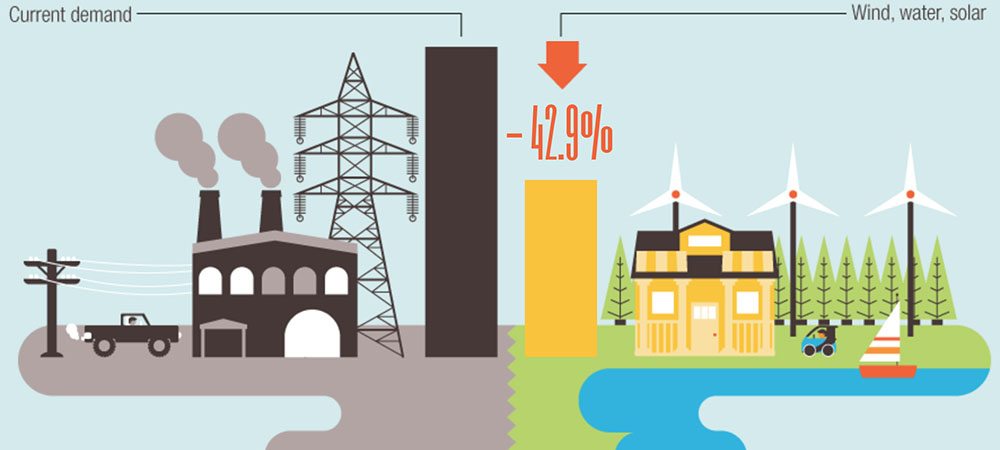Infographie décrivant les plans état par état :
mix-énergétique (curieusement, il manque le solaire thermique, la biomasse…),
les créations d’emploi sur 40 ans (construction/maintenance),
l’économie d’énergie engendrée par le passage au tout électrique,
les économies en santé publique (et du coup la durée nécessaire pour que ces économies équilibrent le coût du plan),
%tage de la surface au sol nécessaire,
le coût de l’énergie dans le futur,
et les économies (santé, climat, coût de l’énergie) réalisées par habitant.

Voir le site The solution project
Article d’origine :
[
Stanford scientist unveils 50-state plan to transform U.S. to renewable energy
Mark Jacobson and his colleagues have created a 50-state roadmap for replacing coal, oil and natural gas with wind, water and solar energy.->http://news.stanford.edu/news/2014/february/fifty-states-renewables-022414.html]
Stanford University scientist Mark Jacobson has developed a 50-state roadmap for transforming the United States from dependence on fossil fuels to 100 percent renewable energy by 2050. He unveiled the plan at the annual meeting of the American Association for the Advancement of Science in Chicago.
“Drastic problems require drastic and immediate solutions,” said Jacobson, a professor of civil and environmental engineering. “Our new roadmap is designed to provide each state a first step toward a renewable future.”
The motivation for the 50-state plan, he said, is to address the negative impacts on climate and human health from widespread use of coal, oil and natural gas. Replacing these fossil fuels with clean technologies would significantly reduce carbon dioxide emissions that contribute to global warming and spare the lives of an estimated 59,000 Americans who die from exposure to air pollution annually, he said.
In recent years, Jacobson and his colleagues have developed detailed proposals for converting the energy infrastructures of New York, California and Washington states to 100 percent wind, water and solar power by 2050. The new plan includes an online interactive map tailored to maximize the renewable resource potential of each of the 50 states. Hovering a cursor over California, for example, reveals that the Golden State can meet virtually all of its power demands (transportation, electricity, heating, etc.) in 2050 by switching to a clean technology portfolio that is 55 percent solar, 35 percent wind (on- and offshore), 5 percent geothermal and 4 percent hydroelectric. Nuclear power, ethanol and other biofuels are not included in the proposed energy mix for any of the states.
“The new map provides all of the basic information, such as how many wind turbines and solar panels would be needed to power each state, how much land area would be required, what would be the cost and cost savings, how many jobs would be created, and how much pollution-related mortality and global-warming emissions would be avoided,” Jacobson said.
The 50-state plan is posted on the website of The Solutions Project, a nonprofit outreach effort led by Jacobson, actor Mark Ruffalo (co-star of The Avengers), film director Josh Fox and others to raise public awareness about switching to clean energy produced by wind, water and sunlight. To publicize the plan, Ruffalo joined Solutions Project member Leilani Münter, a professional racecar driver, at a Feb. 15 Daytona National Speedway racing event that Munter participated in.
“Global warming, air pollution and energy insecurity are three of the most significant problems facing the world today,” said Jacobson, a senior fellow at the Stanford Woods Institute for the Environment and the Precourt Institute for Energy.
“Unfortunately, scientific results are often glossed over. The Solutions Project was born with the vision of combining science with business, policy and public outreach through social media and cultural leaders – often artists and entertainers who can get the information out – to study and simultaneously address these global challenges.”
